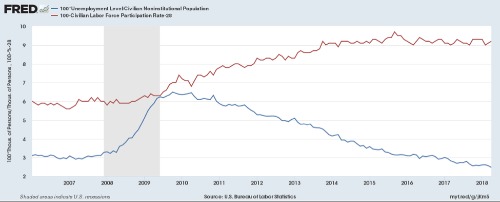Unemployment and inflation are not inextricably linked

The April unemployment rate, released Friday, showed the headline unemployment rate below 4 percent, which has rarely happened in the past 48 years. But a low unemployment rate does not necessarily mean high inflation.
A conventional wisdom, sometimes known as the Phillips curve, holds that low unemployment creates inflation as employers increasingly bid against each other for workers and pass on some of their labor costs to consumers.
{mosads}One problem with the theory is that low unemployment is not synonymous with high employment. Aside from identifying Americans as either working or being unemployed, federal government statisticians also put adults into a third category: out of the labor force (OLF).
In other words, “unemployed” is just one of two not-working categories, so that both employment and unemployment can fall at the same time if enough people are switching from unemployed to out of the labor force.
The official distinction between unemployed and OLF is whether the not-working person is actively looking for work. This distinction helps to prevent confusing a retiree or a full-time student with a laid-off head of household who is eagerly looking for a new job.
But a number of people are on the margin of looking for work and could be classified either way. During President Obama’s first term, the federal government was actively assisting out-of-work people with temporary cash, health and mortgage assistance but only if they said that they were looking for work. That by itself inflated the measured unemployment rate above what it would have been.
When the temporary assistance programs began to expire during 2010 and 2011, that’s exactly when the unemployment rate started falling. Some of that drop was a result of additional employment, but an important part of it was just a shift to the OLF form of not working.
To further add to the statistical distortion, the headline unemployment rate is measured as a share of people in the labor force rather than a share of population. When 3.9 percent of the labor force is unemployed, that means that an even lesser percentage of the adult population is unemployed because a great many adults are not in the labor force.
Increases in the number of people classified as OLF can, therefore, reduce the headline unemployment rate without changing the number of people who actually are unemployed.
The chart below shows unemployment (blue) and OLF (red) on the same scale, which is a fraction of the adult population (I have subtracted 28 points from OLF so that the two series come together around 2010).

Around 2010, the two started moving in opposite directions, and this trend continued until about 2016. By that point, unemployment was historically low, in comparison with the population, but employment was not historically high.
What had really changed between 2010 and 2016 was the propensity of people who are out of work to say that they are actively looking.
The most recent year has been different, with unemployment falling yet no real increase in OLF. But that change is fairly small in comparison to the changes from 2010 to 2016.

The other problem with the Phillips curve theory is that it has been backward many times in history; there have been times of rapid economic growth at the same time that inflation was low or even negative.
The takeaway: If you want to understand what is happening with inflation, look somewhere else than the unemployment rate.
Casey Mulligan is a professor of economics at the University of Chicago. His recent research has focused on non-pecuniary incentives to save and work and how the economy affects policy. His two recent books are, “The Redistribution Recession: How Labor Market Distortions Contracted the Economy,” and “Side Effects: The Economic Consequences of the Health Reform.”
Copyright 2023 Nexstar Media Inc. All rights reserved. This material may not be published, broadcast, rewritten, or redistributed. Regular the hill posts







